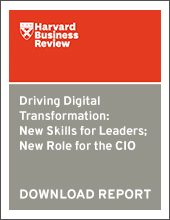It’s becoming increasingly clear that enterprise-wide education is needed around digital technology and IT teams are a natural fit for initiating the effort. After all, who else in the organization should have a better understanding of the digital trends within their industry? But, as organizations embark on their own digital education curriculum, they will fall short if they focus on the information technology team alone.
That's because digital transformation goes well beyond IT. CIOs and IT leaders can and should lead education efforts, but it will quickly become apparent that they need to bring more to the table than their IT skills. It’s not enough to know the capabilities of technology in isolation. IT needs to have understanding of their organization’s strategy, as well as finance, marketing, people, product and legal ramifications. IT needs to be able to speak the language of marketing, HR, sales and manufacturing. Only then can they effectively communicate the value of digital technology and influence widespread enterprise change.
A great example of this is the use of data and analytics. You can be an exceptional data scientist, but if you don't know the business, you may not know the right questions to ask. You need global awareness of specific challenges and opportunities to know that what you’re analyzing matters and why. Similarly, business leaders need to understand the “why” behind digital technology before they can fully comprehend – or even care about – the “what” or the “how.”
New Skills for IT

There are a new set of organization skills evolving around how IT leaders must get their point of view shared with the organization, and it's changing dramatically as a result of digital transformation. Once, growth in responsibility was a somewhat linear progression – you moved up the management chain, secured one or more mentors, and built a reputation in the organization. While those things are still important, leadership in the open organizations of tomorrow will take new forms. The boundaries between roles and responsibilities both inside and outside the organization are increasingly blurred. This creates new challenges and new opportunities for IT relative to influence, communication, education and knowledge sharing.
It is essential that IT leaders have a solid understanding of where they can add the most value, whether it's marketing, supply chain, customer service, or elsewhere. But before approaching that team with the nitty-gritty tactical aspects of a technology project, IT needs to come prepared to discuss the vision for the long term. And, they need to communicate in terms that their business partners will understand.
What we’re doing in Red Hat IT
At Red Hat, our IT organization is working with each of our business partners to help them develop digital strategies and solutions to enable them (and us) to be more effective. We’re investing in the deployment of new communication and collaboration tools in the organization. And we’re trying to better understand the needs of our end users as individuals rather than solely as a part of sales or as a part of marketing. We’re building an internal consulting capability so that we can help our end users be more efficient and effective in their jobs as a community of associates, in addition to being part of a business function.
We’re still in the early stages, and like most enterprises, we still have a long way to go. We must continue to nudge our associates toward self-service and self-support in a bring-your-own-device, bring-your-own-services world. We need to further automate our solutions and equip our internal customers with better out-of-the-box experiences so they become more self-sufficient and more aware of the tools that are available to them. And we need to give them better access to data and analytic tools, as well.
Most importantly, we need to continue to show our associates and business partners the “why,” and empower them to execute the changes we wish to see. That is an opportunity for every IT organization. Is your IT team actively working with your business partners to develop digital strategies and solutions? If so, what are the biggest lessons you’ve learned so far?
ALSO READ
Lee Congdon has more than 25 years of experience as an IT leader. Prior to joining Red Hat® he was managing vice president, Information Technology, at Capital One where he developed and delivered IT solutions for the firm’s corporate functions and Global Financial Services group.




